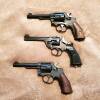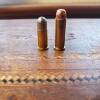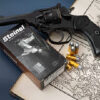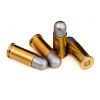I have three guns in 38/200. Two S&W Victories and an Enfield. The one S&W is parked and has a Highlanders unit marking on the backstrap (top), the other looks to be an Australian gun and has a black painted finish (bottom). It appears the painted gun went through a "factory through repair", as it has the FTR stamp on it.
All are fun guns to shoot. But the S&W's are the better shooters.

I load for the round and if youre looking to get one, its about the only way to be able to get the right load.
Its also bout the only way youll likely be able to shoot it much. Factory 38 S&W is salty when you find it, and that was before the panic. When I picked up the Enfield, I didnt have a 38 S&W and wanted to shoot it. Took going to three shops just to find one box, and it was 146 grain Remington "target" ammo, at $35 a box of 50.
I ordered a bunch of Starline brass and once you have the brass, its reasonable to load for. Matts Bullets has a couple of versions of the 200 grain Webley bullets. Ive been using the early MKII version, and with good results.
One thing that struck me the first time I picked the loaded box up was, it felt like I was picking up a box of 45acp, and not a box of "38's". The 200 grain bullets are big, and take up almost as much of the inside of the case as you see outside.
This is the 38/200 with a 200 grain Matts Webley MKII bullet vs a 158 grain 38 Special for comparison...

From what Ive read, the Brits were pretty devious with the load, and the round, while not the powerhouse we Americans seem to need, it seems that the slow moving heavy bullet does some nasty things in the body as it moves through, especially if it hits bone. Dont know about that, but they seem to shoot very well and to POA of the sights.
I have loaded and shot some 357 LSWC's in both the S&W and Enfield, and they shot OK too, but seemed to shoot low for the sights at 10 yards.
If youre looking for one, Id suggest taking a 38 Special with you, or if youre in a shop, ask them to see if it will chamber. If it does, I would walk and keep looking.





























